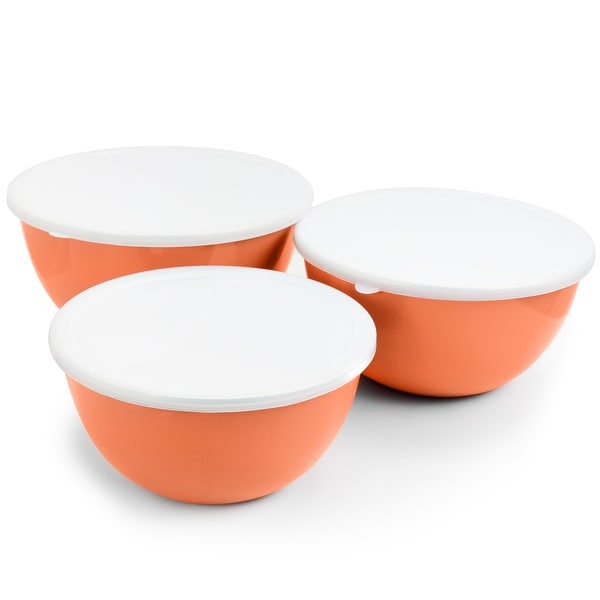
Holding, pouring from, and cleaning stainless steel bowls are a breeze.Even the largest mixing bowls that would be a struggle to hold in glass form are light and easy to maneuver when made of stainless steel. While tempered glass bowls must be heavy to become strong, the even-stronger stainless steel is a lightweight and user-friendly material. They can handle storing heavy items or even gnarly falls without cracking or breaking. These bowls are made to be extremely strong and durable. Unlike glass bowls, you don’t need to worry about dropping a stainless steel mixing bowl. Take a look at how stainless steel mixing bowls can give chefs an edge in kitchens near and far. Like glass mixing bowls, stainless steel bowls have their benefits and drawbacks - but one clearly outweighs the other. Why make these relatively easy parts of kitchen prep harder for yourself? What Are the Pros of Stainless Steel Mixing Bowls? Getting heavier bowls in and out of storage can also be a pain. The weight and slipperiness of glass bowls make holding and pouring from them awkward, and your risk of dropping your bowl becomes much greater when you can’t get a good grip on it. And if you’ve tried holding a glass bowl in one hand and scraping ingredients out with the other, you know how unpleasant an experience that can be. As anyone who spends time in the kitchen knows, transferring and pouring ingredients to and from mixing bowls is a must - especially in baking. Speaking of the risks of dropping glass, these bowls are heavy as heck.

Even a chipped glass bowl can pose a safety risk and become unusable. If you drop a glass mixing bowl, odds are it will break. While considerably less fragile than non-tempered glass, glass mixing bowls are still more delicate than their stainless steel counterparts. While glass mixing bowls have some advantages, there are also a few serious drawbacks to keep in mind. However, if you are using mixing bowls for their intended purpose (AKA, mixing), we find that glass bowls leave a little something to be desired. Some prefer glass bowls for their appearance, as they can be used as decorative bowls on the counter or even for serving. Glass bowls are nonreactive cookware, so you won’t have to worry about any type of chemical reaction messing with the color or taste of your food, as can sometimes happen with certain metal cookware like aluminum or copper. This can help users more clearly see the number of ingredients used and how well-mixed they are. It’s what’s on the inside that counts: Many bakers enjoy the see-through nature of glass bowls, especially if there are measurement lines included on the inside. However, this added strength also adds to the bowl’s weight, making them harder to carry and pour. Glass mixing bowls are usually made of tempered glass, meaning the material has been mechanically strengthened to better withstand impact or high heat. While glass bowls are more fragile than stainless steel, they aren’t quite as breakable as your glass wine glasses or other drinkware. One of the main selling points of glass mixing bowls is that they are microwavable safe, allowing you to conveniently warm any ingredients up without needing to dirty a second bowl. You could say we’re seeing the glass (mixing bowl) half full.


Glass mixing bowls have their own set of benefits and drawbacks, but let’s start with what they get right. While both options have their pros and cons, stainless steel is the clear winner for ease of use and safety.īut don’t worry we’ll break it down further so you can see for yourself. So, that leaves us with the choice of the century: glass vs. Their porous surface can absorb oil and grease, dirtying easily and hanging on to odors. Having a plastic lid can make storage easy, but a fully plastic bowl is an easy no. While ceramic bowls may be nice to look at, they’re too bulky and heavy to pour from and carry with ease - and the last thing you want is to drop your bowl mid-whisk. Think easy to work with, durable, and sturdy. In fact, the ideal mixing bowl should be one that doesn’t make a big fuss. When it comes to a good mixing bowl, you don’t need anything flashy or over the top. But which kind of mixing bowl takes the cake (pun intended)? Whether you’re stirring or whisking ingredients, tossing a salad, soaking beans, marinating meat, or storing leftovers, your trusty mixing bowl has got you covered. Mixing bowls are a classic, a staple, a can’t-make-a-meal-without-it kind of kitchen companion - so it’s no surprise you need a solid one when getting your kitchen in order.


 0 kommentar(er)
0 kommentar(er)
